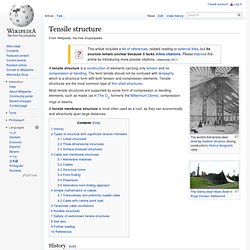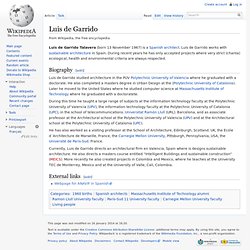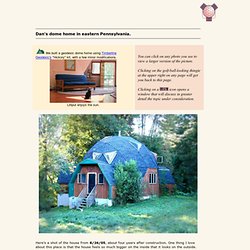

Tensile structure. Most tensile structures are supported by some form of compression or bending elements, such as masts (as in The O2, formerly the Millennium Dome), compression rings or beams.

A tensile membrane structure is most often used as a roof, as they can economically and attractively span large distances. History[edit] This form of construction has only become more rigorously analyzed and widespread in large structures in the latter part of the twentieth century. Tensile structures have long been used in tents, where the guy ropes and tent poles provide pre-tension to the fabric and allow it to withstand loads. Russian engineer Vladimir Shukhov was one of the first to develop practical calculations of stresses and deformations of tensile structures, shells and membranes. Antonio Gaudi used the concept in reverse to create a compression-only structure for the Colonia Guell Church. Steady technological progress has increased the popularity of fabric-roofed structures.
Linear structures[edit] where: Sustainable Domes - Geodesic Dome - Aquaponics Domes. Luis de Garrido. Luis de Garrido Talavera (born 13 November 1967) is a Spanish architect.

Luis de Garrido works with sustainable architecture in Spain. During recent years he has only accepted projects where very strict (chanta) ecological, health and environmental criteria are always respected. Biography[edit] Luis de Garrido studied architecture in the PUV Polytechnic University of Valencia where he graduated with a doctorate. He also completed a masters degree in Urban Design at the (Polytechnic University of Catalonia). During this time he taught a large range of subjects at the information technology faculty at the Polytechnic University of Valencia (UPV), the information technology faculty at the Polytechnic University of Catalonia (UPC), in the school of telecommunications. He has also worked as a visiting professor at the School of Architecture, Edinburgh, Scotland.
Currently, Luis de Garrido directs an architectural firm en Valencia, Spain where is designs sustainable architecture. Ekološka hiša Naomi Campbell bi prestala konec sveta. Geodesic Dome. COCOON TREE - dormir dans les arbres. Natural Spaces Domes. Dan's dome homepage. One of the tricky things is to get all the paperwork & contractors organized so things happen in the proper sequence.

The easy (and more expensive) way to go about this is to simply hire a builder to take care of everything for you, or you can act as your own general contractor and hire all the workers yourself, or, if you're handy and have a LOT of free time, you can do all the work yourself. I opted to go the second route, and save only the dome construction and a few other easy tasks for myself. We were lucky in that we already knew, and trusted, just about everyone else we needed to finish the job. Build a homemade geodesic dome. A Geodesic Dome Some years ago I built a geodesic dome out of ½ inch galvanized steel electrical conduit, to serve as an aviary for chickens and small parrots.

I wrote a computer program to calculate the proper lengths of steel tubing, and draw the diagram shown below: The dome is made from three different lengths of tubing. I used colored stickers on the tubes to mark the different lengths -- red for the long ones, violet for the medium lengths, and green for the short ones. You can see those colors in the drawing.
The ends of the tubes are smashed flat with a hammer, and then holes are drilled in the flat ends for a bolt to go through to connect up to six of the tubes together. For this project, something a little more modest in size is required. For the first attempt at a smaller dome, I used bamboo kebab skewers and gumdrops. You will need these materials for the gumdrop dome: Click on photo for a larger picture The dome is made of pentagons and hexagons. We end up with a nice dome. Vector Foiltec - The specialist ETFE Contractors.